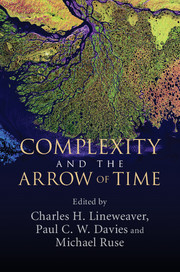Book contents
- Frontmatter
- Contents
- Author biographies
- Part I Introduction
- Part II Cosmological and physical perspectives
- Part III Biological complexity, evolution, and information
- Part IV Philosophical perspectives
- 12 Wrestling with biological complexity: from Darwin to Dawkins
- 13 The role of generative entrenchment and robustness in the evolution of complexity
- 14 On the plurality of complexity- producing mechanisms
- Index
- References
13 - The role of generative entrenchment and robustness in the evolution of complexity
from Part IV - Philosophical perspectives
Published online by Cambridge University Press: 05 July 2013
- Frontmatter
- Contents
- Author biographies
- Part I Introduction
- Part II Cosmological and physical perspectives
- Part III Biological complexity, evolution, and information
- Part IV Philosophical perspectives
- 12 Wrestling with biological complexity: from Darwin to Dawkins
- 13 The role of generative entrenchment and robustness in the evolution of complexity
- 14 On the plurality of complexity- producing mechanisms
- Index
- References
Summary
Evolutionary developmental biology is one of the most complex and articulated of the new sciences emerging out of the intersection of multiple recently separate domains. (Other new hybridizing complexes here include the new embrasure of the very large and the very small – particle physics and the big bang, characteristic of the new cosmology, and the emerging human sciences spanning from cultural anthropology and history through physical anthropology and genetics to economics and sociology.) Evolutionary developmental biology has emerged as one of the most active fields in the Darwinian sciences but the success of evolutionary developmental biology makes central the question of how to integrate an account of development into models of evolution in a general way. Evolution is, after all, the evolution of developmental life-cycles, and this must be central to any account of the evolution of complexity in the biological realm. It is also important to consider the role of developmental perspectives in the intersection of cultural, scientific, and technological evolution, but this will be done below and separately.
In this chapter, I will make some general remarks on the evolution of complexity, and then focus on one of several relevant factors or mechanisms, which I have called “generative entrenchment”, and its interactions with another, robustness. Generative entrenchment has the virtue that it should apply to any evolutionary process in which there are recurrent iterative cycles of processes, and most obviously in development and life cycles. Thus it should apply to cultural, ideational, and technological evolution as well as biological evolution. And it naturally tends to accumulate complexity. Robustness can act as an amplifier of this by reducing genetic load (or processes leading to degradational breakdowns, Kauffman, 1985, 1993; Lynch et al., 1993).
- Type
- Chapter
- Information
- Complexity and the Arrow of Time , pp. 308 - 331Publisher: Cambridge University PressPrint publication year: 2013
References
- 6
- Cited by



